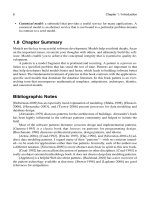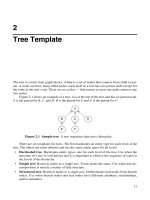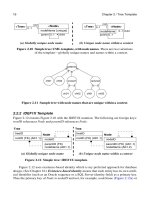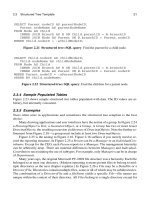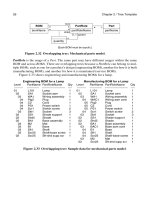PATTERNS OF DATA MODELING- P5 pptx
Bạn đang xem bản rút gọn của tài liệu. Xem và tải ngay bản đầy đủ của tài liệu tại đây (141.38 KB, 5 trang )
1
1
Introduction
Models provide the means for building quality software in a predictable manner. Models let
developers think deeply about software and cope with large size and complexity. Developers
can think abstractly before becoming enmeshed in the details of writing code. Although
models are beneficial, they can be difficult to construct. That is where patterns come in. Pat-
terns provide building blocks that help developers construct models faster and better.
This chapter starts with a discussion of models and then introduces the topic of patterns.
1.1 What Is a Model?
A model is an abstraction of some aspect of a problem. Most software models are expressed
as graphical diagrams and by their form appeal to human intuition. Developers must under-
stand a problem before attempting a solution. Models let developers express their under-
standing of a problem and communicate it to others — technologists, business experts, users,
managers, and other project stakeholders. Developers can focus on the essence of an appli-
cation and defer implementation details. Chapter 8 of [Blaha-2001] lists additional reasons
for building models.
There are various kinds of models (such as data models, state-transition models, and
data-flow models) that are used for databases, programming, and other purposes. This book
concerns data models and the focus is on databases.
1.2 Modeling Notation
Data modeling has no widely-accepted, dominant notation. To appeal to a broad audience,
this book uses two notations—UML (Unified Modeling Language) and IDEF1X—and pres-
ents most patterns and models with both notations. These notations largely express the same
2 Chapter 1 / Introduction
content, so you can readily understand this book as long as you are fluent with either one.
The Appendix summarizes both notations and gives references for further details.
1.2.1 UML
The UML’s data structure notation specifies entities and their relationships. This sets the
scope and level of abstraction for subsequent development. The UML encompasses about a
dozen notations of which one (the class model) concerns data structure.
The UML data structure notation derives from the original Chen notation [Chen-1976].
The Chen notation and its derivatives have been influential in the database community, but
there are many dialects and a lack of consensus. This UML data structure model is just an-
other Chen dialect, but one that has the backing of a standard. The Object Management
Group has been actively working towards standardizing all of the UML notations.
The UML is normally used in conjunction with object-oriented jargon which I avoid.
Object-oriented jargon connotes programming which I do not intend. This book’s focus is
on data modeling.
1.2.2 IDEF1X
The IDEF1X notation [Bruce-1992] specifies tables, keys, and indexes. IDEF1X also is a
standard language and has been in use for many years. IDEF1X is closer to database design
than the UML and more clearly shows the details of patterns.
1.2.3 Using Both Notations
In my consulting practice, I use both notations. I start with the UML to conceive the abstrac-
tions of an application. Then I translate the ideas into IDEF1X and add database details.
From IDEF1X I generate database code. The UML is good for abstract modeling and not for
database design. IDEF1X is good for database design and not for abstract modeling. Both
notations are useful, but each has its place.
1.3 What Is a Pattern?
This book defines a pattern as a model fragment that is profound and recurring. A pattern is
a proven solution to a specified problem that has stood the test of time. Here are some other
definitions from the literature.
• A pattern solves a problem in a context. [Alexander-1979]
• “A pattern for software architecture describes a particular recurring design problem that
arises in specific design contexts, and presents a well-proven generic scheme for its so-
lution.” [Buschmann-1996]
• “A pattern is a template. It’s a template that is an example worthy of emulation, and
something observed from things in actuality. It’s a template to a solution, not a solution.
It’s a template that has supporting guidelines (not so much that it keeps one from seeing
how it might be used in novel ways).” [Coad-1994]
1.4 Why Are Patterns Important? 3
• “A pattern is a template of interacting objects, one that may be used again and again by
analogy.” [Coad-1995]
• “A pattern provides a proven solution to a common problem individually documented
in a consistent format and usually as part of a larger collection.” [Erl-2009]
• “A pattern is an idea that has been useful in one practical context and will probably be
useful in others.” [Fowler-1997]
• “A design pattern systematically names, motivates, and explains a general design that
addresses a recurring design problem It describes the problem, the solution, when to
apply the solution, and its consequences.” [Gamma-1995]
• “A pattern describes a problem to be solved, a solution, and the context in which that
solution works. It names a technique and describes its costs and benefits. Developers
who share a set of patterns have a common vocabulary for describing their designs, and
also a way of making design trade-offs explicit. Patterns are supposed to describe recur-
ring solutions that have stood the test of time.” [Johnson-1997]
• “A pattern is a recurring solution to a standard problem Patterns have a context in
which they apply.” [Schmidt-1996]
• A pattern is “a form or model proposed for imitation.” [Webster’s dictionary]
• “In general, a pattern is a problem-solution pair in a given context. A pattern does not
only document ‘how’ a solution solves a problem but also ‘why’ it is solved, i.e. the ra-
tionale behind this particular solution.” [Zdun-2005]
Since this book is about data modeling, the patterns focus on data structure (entities and re-
lationships). I de-emphasize attributes as they provide fine details that can vary for applica-
tions.
1.4 Why Are Patterns Important?
Patterns have many benefits.
•
Enriched modeling language. Patterns extend a modeling language—you need not
think only in terms of primitives; you can also think in terms of frequent combinations.
Patterns provide a higher level of building blocks than modeling primitives. Patterns are
prototypical model fragments that distill the knowledge of experts.
•
Improved documentation. Patterns offer standard forms that improve modeling unifor-
mity. When you use patterns, you tap into a language that is familiar to other developers.
Patterns pull concepts out of the heads of experts and explicitly represent them. Devel-
opment decisions and rationale are made apparent.
•
Reduce modeling difficulty. Many developers find modeling difficult because of the in-
trinsic abstraction. Patterns are all about abstraction and give developers a better place
to start. Patterns identify common problems and present alternative solutions along with
their trade-offs.
4 Chapter 1 / Introduction
• Faster modeling. With patterns developers do not have to create everything from
scratch. Developers can build on the accomplishments of others.
• Better models. Patterns reduce mistakes and rework. Each pattern has been carefully
considered and has already been applied to problems. Consequently, a pattern is more
likely to be correct and robust than an untested, custom solution.
•
Reuse. You can achieve reuse by using existing patterns, rather than reinventing solu-
tions. Patterns provide a means for capturing and transmitting development insights so
that they can be improved on and used again.
1.5 Drawbacks of Patterns
Even though patterns have much to offer, they are not a panacea for the difficulties of soft-
ware development.
• Sporadic coverage. You cannot build a model by merely combining patterns. Typically
you will use only a few patterns, but they often embody core insights.
• Pattern discovery. It can be difficult to find a pertinent pattern, especially if the idea in
your mind is ill-formed. Nevertheless, this difficulty does not detract from the benefits
when you find a suitable pattern.
• Complexity. Patterns are an advanced topic and can be difficult to fully understand.
• Inconsistencies. There has been a real effort in the literature to cross reference other
work and build on it. However, inconsistencies still happen.
• Immature technology. The patterns literature is active but the field is still evolving.
1.6 Pattern vs. Seed Model
It is important to differentiate between patterns and seed models. The programming pattern
books, such as [Gamma-1995], have true patterns that are abstract and stand apart from any
particular application. In contrast most of the database literature ([Arlow-2004], [Fowler-
1997], [Hay-1996], [Silverston-2001a,b]) confuses patterns with seed models.
A seed model is a model that is specific to a problem domain. A seed model provides a
starting point for applications from its problem domain. Seed models are valuable in that
they can save work, reduce errors, contribute deep insights, and accelerate development.
Thus seed models are truly useful. But if you are working in a different problem domain,
you must first find the relevant seed models, understand the seed models, extract the implicit
patterns, and then apply the patterns to your own application. In contrast, this book makes
patterns explicit so that they are ready to go for any problem domain. Table 1.1 contrasts pat-
terns with seed models.
1.7 Aspects of Pattern Technology 5
1.7 Aspects of Pattern Technology
My usage of the term pattern is different than the literature but consistent with the spirit of
past work. I treat pattern as an overarching term encompassing mathematical templates, anti-
patterns, archetypes, identity, and canonical models.
• Mathematical template: an abstract model fragment that is useful for a variety of appli-
cations. A mathematical template is devoid of application content. Mathematical tem-
plates are driven by deep data structures that often arise in database models. Most tem-
plates have a basis in topology and graph theory, both of which are branches of mathe-
matics.
Mathematical templates have parameters that are placeholders. The parameters
must be instantiated for each use. I use the notation of angle brackets to denote template
parameters. You incorporate a mathematical template into a model by substituting ap-
plication concepts for the parameters.
• Antipattern: a characterization of a common software flaw. An antipattern shows what
not to do and how to fix it. The literature emphasizes antipatterns for programming but
they also apply to databases.
• Archetype: a deep concept that is prominent and cuts across problem domains. This
book’s archetype models are small and focus on core concepts. [Arlow-2004] nicely ar-
ticulates the idea of an archetype, but their models are so large that they are really more
like seed models. A small model is more likely to be application independent and widely
reusable than a large model.
• Identity: the means for denoting individual entities, so that they can be found. There are
different aspects of identity that deeply affect application models.
Characteristic Data modeling pattern Seed model
Applicability
Application independent Application dependent
Scope
An excerpt of an application Intended to be the starting point
for an application
Model size
Typically few concepts and rela-
tionships (< 10)
Typically 10-50 concepts and
relationships
Abstraction
More abstract Less abstract
Model type
Can be described with a data
model
Can be described with a data
model
Table 1.1 Pattern vs. Seed Model
Note: A pattern is abstract and stands apart from any particular application,
unlike a seed model.



